
Ever since their theatrical cartoon debut in 1940, no one can seem to get enough of Tom and Jerry. The cat and mouse, created by Bill Hanna and Joe Barbera at MGM, have chased their way through decades of animated shorts, TV shows, comics, and feature films, and are still popular today.
This little 4-by-7 inch storybook from 1949 gives us not only some nice color and black and white illustrations, but a storyline based loosely on two theatrical cartoons. While only referred to as “the baby” here, the little orphan mouse is Nibbles (later named Tuffy), and the plot is taken from his first cartoon appearance The Milky Waif (1946). The book also uses some plot elements from Mouse Trouble (1944). The author and artist are unknown, but the publisher, Whitman, was a subsidiary of Western Publishing, which also published “Tom and Jerry” comic books under their Dell Comics banner.
Bill Hanna, Joe Barbera and their team of animators at MGM often experimented with adding new characters to keep the “Tom and Jerry” series fresh. Interestingly enough, the “Nibbles” character appeared in the comic books first, as early as 1942, serving as a sidekick for Jerry. That lead to his animated debut in 1946. A second cartoon appearance, The Little Orphan (1949) won an Academy Award, cementing the character as a regular in cartoons, comics, and merchandise like this book.
It should also be noted that unlike the largely pantomime humor of the cartoons, print adaptations of Tom and Jerry usually feature dialogue.
(click page spreads to enlarge)

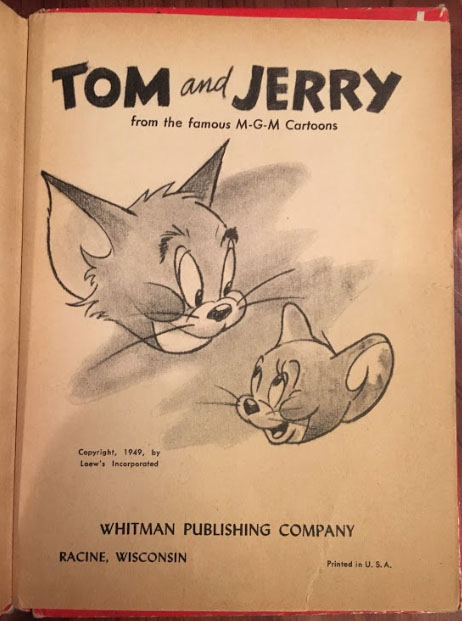




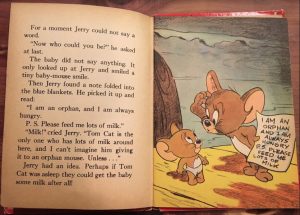

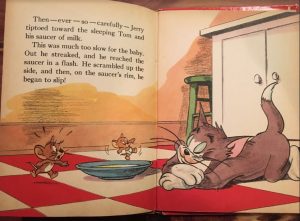
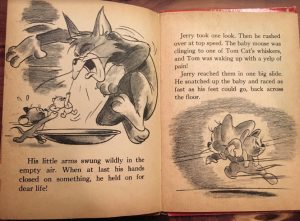
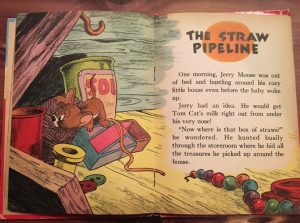


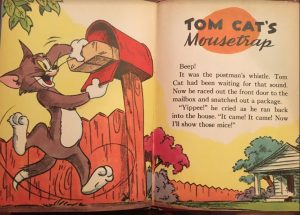
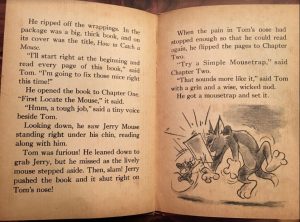
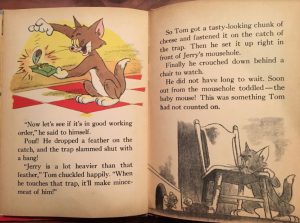
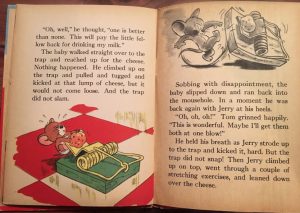
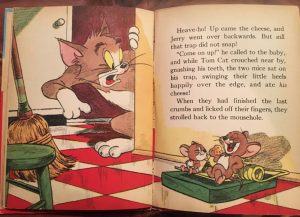
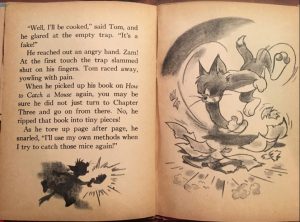

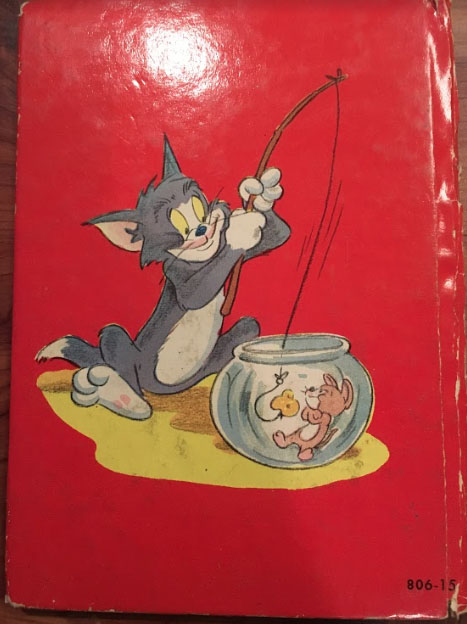
I recall Whitman also putting out comics and coloring books in the 1960’s based around classic Hanna-Barbera TV characters; I had a FLINTSTONES book, but it would sometimes feature “guest” appearances by some of the other characters.
I happen to like “THE MILKY WAIF” quite a bit; I like some of Tom’s poses in that cartoon and I especially enjoy the score. And I do remember Tom and Jerry “dialogue balloons” in TOM AND JERRY comics. I wondered whether there was a terrific and interesting graphic way to do entire TOM AND JERRY panels or stories without dialogue, similar to the cartoons. Hey, Charles Schultz did this with some CHARLIE BROWN strips when it came to Snoopy and Linus. Remember the strips where Snoopy liked to sneak up on Linus, grab his blanket and run off down the street…even if Linus was still clinging to it? I remember a whole Sunday strip with panel after panel following Snoopy, dragging Linus around the grounds, through trees and over bushes and around corners. Although I can’t recall the “punchline” to the strip, sometimes delivered by Linus, I do recall that all that action was neatly laid out on paper. I just imagined Tom and Jerry panels created like that.
I first became aware of the cat and mouse through the comic books and was I surprised to learn, once I found out about their classic MGM theatrical cartoons, that they never *DID* talk (save for a few moments in a cartoon or two, perhaps spurred on by the fact that they exchanged dialogue in the comics panels)! Also, I wonder whether or not Tom had those varying shades of gray in the older comics. I’d only seen the simple gray and white on Tom with those large, elephantian ears and yellow eyes, while, on an MGM cartoon like “THE MILKY WAIF”, Tom could appear almost closer to black with a gray belly and gray between his eyes. Nibbles (or Tuffy) was the basic gray and white.
I have that same book somewhere in the recesses of my ‘crypt of collectibles’ – haven’t seen it in years – but I remember I always thought that those drawings, as nice as they are in the book, were actually the result of a less sure hand tracing Harvey Eisenberg drawings.
Maybe the art had to be redone in pencil and watercolor for publication . . . but although those are definitely Eisenberg poses, they just don’t look like his refined finished work as was on display in the DELL Tom and Jerry comics.
I recently acquired a copy of another T&J storybook, published a year later, with art by Eisenberg (and credited). If Carl Barks was the master of Disney duck comics, then Harvey Eisenberg was certainly the master of the Tom and Jerry comics.
What is the name of the storybook?
Tom Ray who worked on these films did illistrate couple of these books.
I’ve seen different Tom and Jerry comic books published by Dell,Top,Gold Key, Whitman (who sold them in a twin/triple pack in retail and drug stores like Woolworth,Savon,Newberrys and Rexall) and most recently Harvey Comics under the Harvey Classic banner There are two rare versions of Tom and Jerry comic books, one from 1942 which also featured Our Gang (who both starred for MGM) with shows Jerry as a grey mouse with a pointy nose instead of the brown mouse with the small nose. Mammy Two Shoes was also in that comic book known as Diana and works for a “Miss Alice” who I presume is the owner of the house. And a very rare one from England which came around Christmas time in the 1970s where Tom preparing for a Christmas Feast with a roast turkey while wearing a paper soldier’s helmet (which he got from a Christmas Cracker which is a party Favor with a surprise inside it which includes a paper party,jokes and a trinket. And inside the turkey was Jerry as “mouse stuffing” with the look on Jerry’s face when he was to be devoured by Tom was priceless! There’s also a rare Tom and Jerry comic strip drawn by Fred Quimby himself!
Pretty sure the comic strip you mention was NOT drawn by Quimby.
Walter Perkins
Hello, I saw you mentioned Walter Perkins. He was my father in law, who passed away at 94 on August 30th. He was one of the artist of this wonderful creation. Tom & Jerry. His memorial will be on 9/26/2018 in couerd’alane, Idaho.
We met Walter when he wintered in Wickenburg, Az. My husband, Steve, golfed with Walter in the Men’s Golf League Group. When h fell and broke his arm, he painted in his recovery and showed his work at the WCC. Such a nice and talented man.
Oh, and Jerry, you forgot to take a picture of two pages.